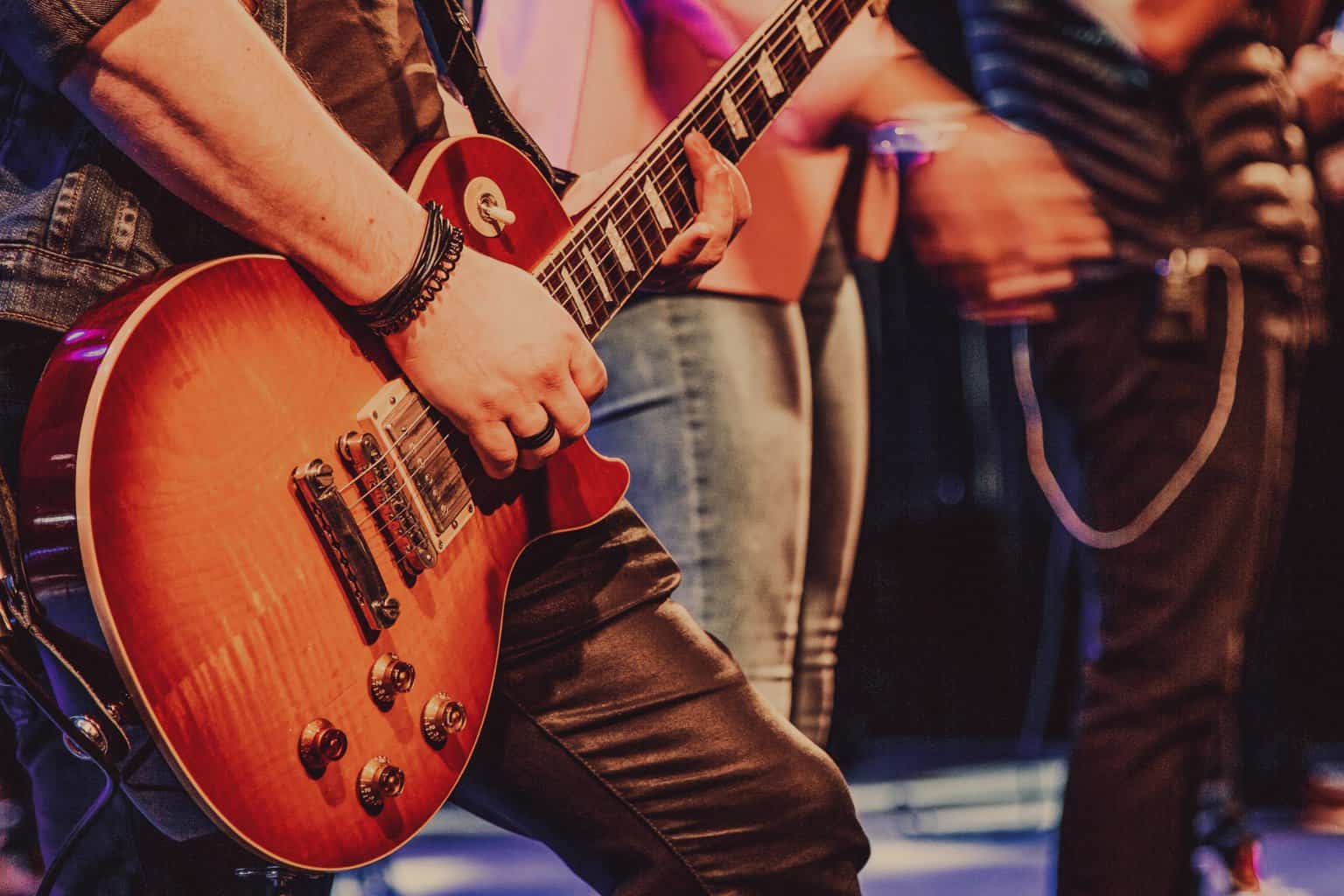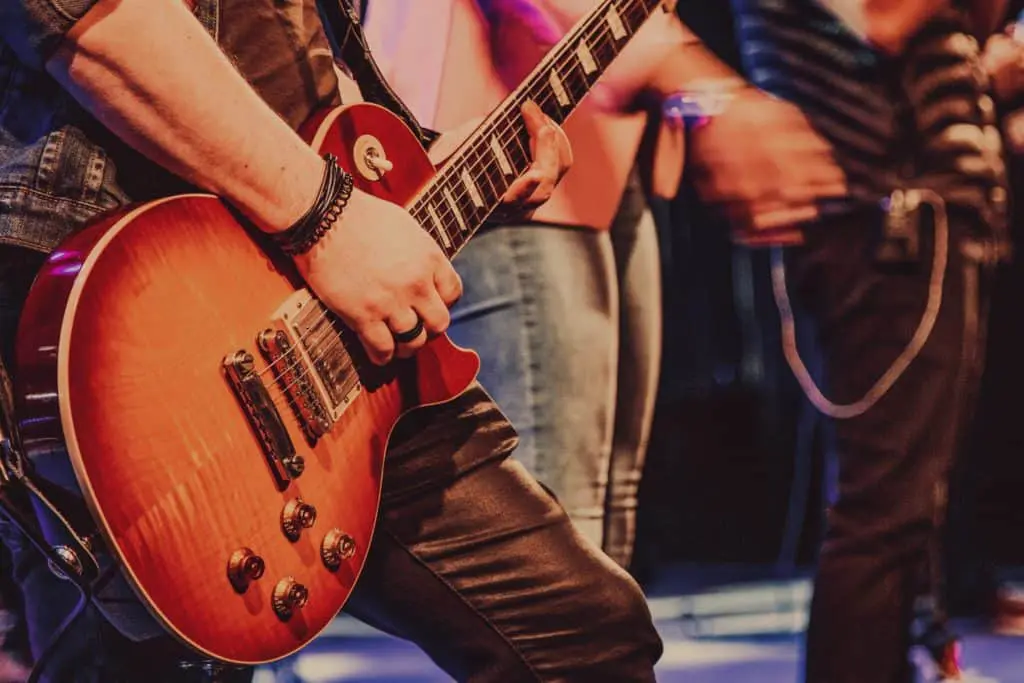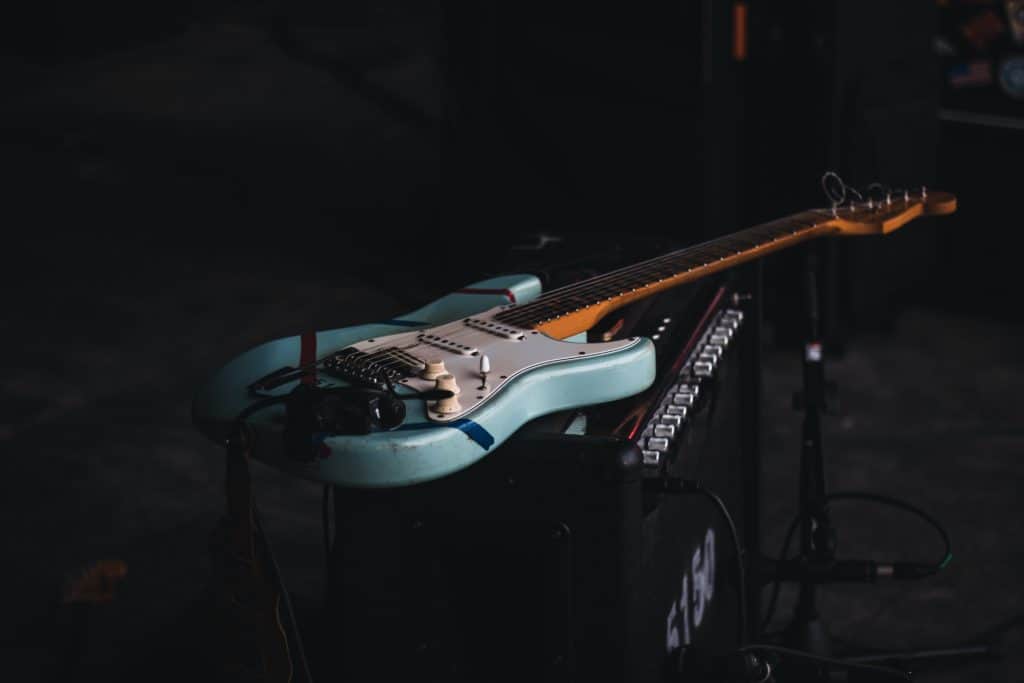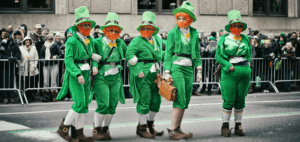Irish Rock bands throughout the decades: Exploring Ireland’s fascinating history through music

Updated On: April 16, 2024 by Ciaran Connolly
Music is one of the most popular aspects of Irish life. We have always been associated with traditional Irish music and dance, but we have also made our mark on the international scene. For a relatively small country we have produced some of the biggest rock bands of all time.
So how did so many talented Irish Rock Bands from the small island of Ireland become international legends? In this article we will explore the unusual rise of Irish rock music.
What is Rock Music?
Rock and roll music, or simply rock, was inspired by the Blues and the Pentatonic Scale. Other genres that have contributed some of their style to the genre are folk, jazz, country and classical music. Common features of rock include electrical instruments such as guitars, bass as well as keyboards and drums. The parameters of rock music are ambiguous at times.
Rock has some common characteristics however, such as a strong beat and a lead voice which often rally’s a powerful anti-establishment message or explores an emotional theme. As we have said, it is hard to find an exact definition for the genre, quite simply because it is by nature ever-evolving. Even Irish rock music is distinct from other countries and it is quite normal for one rock band to have a completely different sound to other rock bands.
So that being said, rock music in Ireland is an exciting sound to uncover! In this article we will explore how rock and music in general evolved in Ireland.
1960’s Irish Rock Music: Irish showband era
Before rock and roll reached Ireland, the main form of musical entertainment was presented in the form of a showband. In the early 1960’s the only viable way to make a career as a musician was by performing in these showbands. A showband was a dance band consisting of 6 to 7 members. To be popular, showbands were expected to perform standard dance numbers as well as pop music hits in the charts. They had to learn every popular genre in Ireland, from country, to pop as well as jazz and even Irish céilí.
The show band was almost like a variety show and acts needed to be multi-talented to be successful. Showbands offered members a chance to hone their performing skills, but the audience had very little interest in original music among emerging artists.
At its height, there were over 800 showbands performing around Ireland and even a few internationally, employing thousands of people in the music industry. In the late sixties however , a second wave of musicians would grow in popularity; rock, blues and soul became most popular in urban areas while country was favoured in rural towns and villages.
Just as the showband had replaced the ‘big band’ or orchestra, rock bands would begin to take over the music scene in Ireland. The true decline of showbands was in the 1970’s, but by this time many bands were adjusting their style and transitioning into smaller rock bands or country music acts. Artists such as Van Morrison started out in a showband but revamped their style at this time. Van Morrison would go on to put Ireland and the city of Belfast on the rock and roll map of fame.
1970’s Irish Rock Music: Irish rock bands and the birth of punk
By the 1970’s rock was highly in demand in Ireland. Most showbands had moved with the times and were actively creating their own music. Van Morrison was already in New York recording what would become his first studio album, ‘Blowin’ Your Mind!’ which featured ‘Brown Eyed Girl’, a song that would garner international fame.
Other Irish bands began to form, including Dublin band Thin Lizzy and the Horslips, both of whom are credited with creating or at least popularising ‘Celtic rock’ by mixing hard rock with traditional Irish music to create synergising tunes that are still being sampled today.
Thin Lizzy had hits during this time such as:
- The Boys are back in Town (1976)
- Dancing in the Moonlight (1977)
- Whiskey in the Jar (1972)
Thin Lizzy performing Whiskey in the Jar in 1973.
Before the 70’s it was a general rule that to be a successful musician, you had to be part of a popular showband or leave the country to perform to a larger audience. The aforementioned bands broke this rule, proving that Ireland was ready to support its rock musicians.
As rock developed throughout the country, a more rebellious movement was born. Punk Rock defied the expectations of popular rock; it was fast paced, self produced, short in nature and often politically charged. Punk rock was more than just music, it became a subculture in and of itself. Punk was by definition anti-establishment and promoted individual freedom with a DIY-ethic.
There was a type of garage band authenticity that people could relate to, music wasn’t just about sounding nice anymore; it had become an authentic way of communication and voicing frustrations. Punk rock was born at a time of great social change across Ireland; punk rock was the soundtrack of the upheaval.
Traditional ideals were in jeopardy as American teenage culture was exposed to young people via cinema and music. Punk became one of the most popular youth subcultures at the time for what it represented: a sort of unity among ‘outsiders’ during a time of international conflict.
In Northern Ireland, the Undertones (the band who originally wrote Teenage Kicks) and Stiff Little Fingers became popular bands. In 1978 the Undertones performed Teenage Kicks live on Top of the Pops, a British chart TV show which exposed them to a large audience. The Boomtown Rats (famous for I Don’t Like Mondays and the lead singer Bob Geldof) were one of Dublin’s many answers to the punk scene.
The 1970’s also saw one of the darkest periods for music in the history of Ireland. Three members of the Miami Showband, Fran O’Toole, Tony Geraghty, and Brian McCoy, were killed in 1975 during the Troubles when returning from a gig in co. Down to the Republic of Ireland. Many international acts refused to perform in Northern Ireland for a long time after this horrific event.
Punk was predominantly popular in the major cities of Ireland and Northern Ireland. The rural areas of Ireland tended to favour more traditional music.
Amidst a sea of punk and rock talent, the 70’s also saw a roots revival of traditional Irish music with young performers popularizing the music of their ancestors. A good example of this is Planxty, a group which toured Ireland playing Irish folk music. Christy Moore actually began his music career as part of Planxty, and has gone on to be one of the most beloved Irish folk / country singers of all time.
1980’s Irish Rock Music: Alternative rock grows in Ireland
In the 1980’s Punk rock had become fractured; for all of its influence on youth culture, Punk wasn’t as profitable as other music genres. New Wave rock was created to promote punk rock in a more marketable way, while Post-punk and alternative rock would fill the artistic gap left by punk during the 80’s and into the 90’s.
In 1981 the first gig was held at Slane castle co. Meath, headlined by Thin Lizzy with U2 and Hazel O’Connor supporting. This was the perfect symbol of Irish Rock in the music industry; it had cemented itself into Irish culture and wasn’t going anywhere. In fact Irish Rock music was just beginning. The following decade would see one of the biggest bands of all time hail from Dublin. The tradition of concerts at Slane castle has gone on for over 40 years, with the best of international and Irish rock acts performing.
During the 80’s alt rock became popular as it continued to discuss social issues authentically. Alt-rock was a broad term used to cover music that did not fit into the hard rock or metal categories that became popular at the time. It was a natural progression of punk, retaining its artistic focus while allowing artists to draw from other styles of music that inspired them. U2, Ireland’s biggest band of all time emerged during this era. The 1980’s saw the four Irish lads release seven albums (including Boy and The Joshua Tree) to critical and commercial success, inspiring a whole new generation of Irish musicians along the way.
Irish rock songs: U2 – Still haven’t found what I’m looking for
Other alt-rock artists that gained fame during this decade included Sinead O’Connor and rock group Aslan, both of whom would go on to have very successful careers spanning decades. The Waterboys also entered the rock scene, with members from Ireland, England, Scotland and Wales over the years.
While alt rock had gotten into its stride, an entirely new genre of Irish music was created by the Pogues. Known as Celtic Punk, the genre encompassed the best of both genres. They offered authentically produced songs that told real stories and felt raw, combined with the character and emotion that is part of traditional Irish music.
The Pogues created their own songs and covered classic Irish folk songs that had been performed by Irish folk legends such as the Dubliners. They covered songs in their own unique style however, the music they created felt truly unique.
In a similar vein Clannad, an Irish family band from Gweedore co. Donegal bridged the gap between pop rock and traditional Irish music one song at a time. The sixth member of the group who left to pursue a solo career was none other than Enya, one of the most successful female Irish singers of all time. Her modern Celtic discography includes Only Time, Orinico Flow and May it be.
Heavy metal never reached the same heights as other types of Irish rock music, but artists such as Mama’s Boys had their fair share of fans in the 80’s with hits like Needle in the Groove.
1990’s Irish Rock Music
The late 80’s saw the formation of Galwegian band, The Saw Doctors, but their real success began in the nineties. The Saw Doctors were one of the first indie rock bands in rural Ireland to achieve success around the country. Musical careers had often been reserved for major cities so it was refreshing to see a band from the town of Tuam go on to tour the UK and US. There is a country influence on their music with no attempts to hide their roots or Galway accents. In fact, the group embraces their unique standing, writing songs such as The Green and Red of Mayo and The N17 which have become classics in the West of Ireland.
The late 80’s and early 90’s also saw the rise of Shoegazing, a sub-genre of alt rock similar to the Uk’s britpop, which of course mainly refers to the rivalry of Oasis and Blur and is characterised by brighter catchier rock songs that have a distinctively British feel. By definition, Shoegaze was brighter and catchier than previous rock genres. Common characteristics of the genre include obscured vocals, guitar distortion and other sound effects. Dublin band My Bloody Valentine are credited with pioneering and creating the genre.
More mainstream Irish alt or Indie rock was the most popular genre of the nineties however. The nineties was a great time for Irish bands, with groups such as The Cranberries, The Frames and The Coors entering the scene.
The Cranberries are one of the most quintessential alt indie rock bands of the 90’s. Hailing from Limerick, the group used their music as a platform to discuss societal and social issues and have created some of the most iconic Irish songs of all time.
1998 saw the release of Weatherman from the newly established Irish rock group Juniper. They split up soon after into a solo artist and band you may know, none other than Damien Rice and Bell X1 respectively. Rice set off for a solo career garnering international success with songs such as cannonball, 9 crimes, the blowers daughter and delicate. Bell X1 also had their fair share of hits with tunes such as Rocky Took a Lover, Eve the Apple of my Eye and The Great Defector, so things seemed to work out well for all parties involved!
2000’s Irish Rock Music
The early 2000’s saw Damien Rice take the world by storm with his folk / indie rock album O in 2002, followed by 9 in 2006. Rice was often accompanied vocally by fellow Irish singer Lisa Hannigan who would go on to gain success as a solo artist soon after. His stripped back acoustic pop rock took the world by storm.
Other popular Irish rock bands such as the Script, Snow Patrol, The Coronas, The Blizzards, Two Door Cinema Club, Ham Sandwich and the Heathers entered the music scene at this time
Rock music was characterised in this decade with polished studio arrangements, lively beats and strong vocals, though there was still often a genuine message behind the tune.
Alongside Damien Rice, the 2000’s saw a rise in popularity of solo Irish rock artists such as Damien Dempsey, Paddy Casey, Declan O’Rourke and Mundy. Indie Rock was thriving and by the late naughties social media was beginning to become a platform for younger artists to showcase their skill.
The 2000’s saw the rise of Irish music festivals such as Oxegen, Electric Picnic, Indiependence and Belsonic gave emerging Irish acts a platform to showcase their music, and they are still doing so today. They were the highlight of the year for young music lovers and a sign of great things to come for new performers.
Irish Rock Music 2010’s
With the arrival of social media, young aspiring Irish artists were given a new platform to gain an international audience. Acts like Hudson Taylor, Hermitage Green, David Keenan and the Academic rose to fame in Ireland during this decade.
Perhaps one of the defining Irish rock music moments of the decade was the release of Hozier’s 2013 debut EP which featured Take me to Church. The song and its music went viral online and seemingly overnight Hozier’s place in the alt/indie rock music genre was well and truly cemented.
Hozier’s style of socially conscious music that wasn’t afraid to start difficult conversations was appreciated around the world. Hozier proved to be one of the standout artists of his time, with his self titled album Hozier and second album Wasteland Baby! being a critical and commercial success.
Towards the later half of the decade Fontaines DC rose to fame with their fresh take on the post-punk genre, combining traditional rock elements with their love of all things poetry and literature. Inhaler, another Irish rock group formed in 2012 reached critical success by the end of the decade.
Irish Rock Music 2020’s
Rising to fame in 2019 with his debut album Without Fear, Dermot Kennedy created a refreshing body of music blending the now typical folk rock now associated with Ireland with hip-hop styles, creating a type of pop music that transcends any one genre yet makes clear homages to the music of Van Morrison and Damien Rice.
Irish rock music is in an exciting place right now as future artists are growing up in the streaming era of music with unparalleled access to explore genres and styles from all around the world.

Final Thoughts
At a first glance, it may be hard to discern any real path that connects music throughout the years, but when you take a deeper dive it is clear that Ireland is a melting pot of creativity. Genres, ideas and artists both pay homage to the music that inspired them and strive to add their own unique flair to the work that they produce. The result is something exciting and almost contradictory; it is naturally familiar, yet fresh and exciting.
It is interesting to see how popular music changes with time, as each generation emerges with a new unique sound. Yet even in our search of the best new music, timeless classics are never forgotten.
We hope that you have enjoined this article, are there any Irish rock bands that deserve a mention in this blog? Please let us know in the comments below!
Other articles that you may enjoy:
- top 14 Irish musicians of all time
- Irish tradition: Music, Sport Folklore and more!
- Best 20 Irish actors
- Irish people who made history in their lifetime







